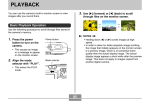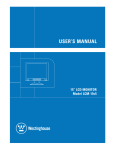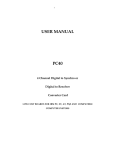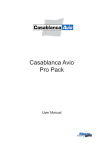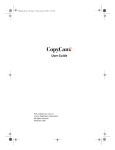Download File 3 - Support
Transcript
PLAYBACK PLAYBACK 3. Use [왘] (forward) or [왗] (back) to scroll You can use the camera’s built-in monitor screen to view images after you record them. through files on the monitor screen. Basic Playback Operation Use the following procedure to scroll through files stored in the camera’s memory. NOTES 1. Press the power Power button • Holding down [왗] or [왘] scrolls images at high speed. • Note that the images produced on the monitor screen of this camera are simplified versions of the actual image stored in memory. button to turn on the camera. • This causes an image or a message to appear on the monitor screen. 2. Align the mode ON/OFF Mode selector selector with “PLAY”. • This enters the PLAY mode. PLAY REC MENU 80 PLAYBACK 1. In the PLAY mode, use [왗] and [왘] to scroll Flipping the Display through images on the monitor screen and display the one you want. The following procedure flips the image 180 degrees. This comes in handy when you want to show someone standing in front of you an image on the monitor screen. 2. Press the shutter release button and [SET] at the same time. [SET] • This flips the image 180 degrees. The histogram or any other display information you had displayed is cleared automatically whenever you flip the image. • While an image is flipped, you can use [왗] and [왘] to scroll to another image, if you want. SET 3. To return the image to its normal orientation, press any button other than [왖], [왔], [왗], or [왘]. Shutter release button IMPORTANT! • Note that you cannot play a movie on the monitor screen while a flipped image is displayed. • You cannot use the above procedure to flip an image while a zoomed image, 9-image screen, or calendar screen is on the display, or while a movie is playing. SET 81 PLAYBACK 3. Use [왖], [왔], [왗], and [왘] to shift the image Zooming the Display Image up, down, left, or right. Perform the following procedure to zoom the image currently on the monitor screen up to four times its normal size. 4. Press [MENU] to return the image to its original size. 1. In the PLAY mode, use [왗] and [왘] to display IMPORTANT! the image you want. • You cannot enlarge a movie image. • Depending on the original size of the recorded image, you may not be able to zoom a display image the full four times its normal size. 2. Press the zoom button ( ) to enlarge the image. • This displays an indicator that shows the current zoom factor. • You can toggle between the zoomed image and normal image by pressing [MENU]. Current zoom factor 82 PLAYBACK 4. Use [왖] and [왔] to select the setting you Resizing an Image want, and then press [SET]. You can use the following procedure to change a snapshot image to either SXGA size (1280 x 960 pixels) or VGA size (640 x 480 pixels). • VGA is the optimum image size for attachment to e-mail messages or incorporation into Web pages. 1. In the PLAY mode, press [MENU]. To do this: Select this: Resize to 1280 x 960 pixels (SXGA) 1280 x 960 Resize to 640 x 480 pixels (VGA) 640 x 480 Cancel the resizing operation Cancel IMPORTANT! 2. Select the “PLAY” • Resizing an image creates a new file that contains the image in the size you select. The file with the original image also remains in memory. • Images smaller than 640 x 480 pixels cannot be resized. • Note that you can resize snapshots recorded with this camera only. • If the message “The function is not supported for this file.” appears, it means that the current image cannot be resized. • The resize operation cannot be performed if there is not enough memory to store the resized image. tab, select “Resize”, and then press [왘]. 3. Use [왗] and [왘] to scroll through images and display the one you want to resize. 83 PLAYBACK 5. Use [왖], [왔], [왗], and [왘] to move the Cropping an Image cropping boundary up, down, left, or right until the area of the image you want to extract is within the boundary. Use the following procedure when you want to crop a portion of an enlarged image and use the remaining part of the image as an e-mail attachment, Web page image, etc. 6. Press [SET] to extract the part of the image 1. In the PLAY mode, use [왗] and [왘] to scroll enclosed in the cropping boundary. through images and display the one you want to crop. • If you want to cancel the procedure at any point, press [MENU]. 2. Press [MENU]. IMPORTANT! • Cropping an image creates a new file that contains the cropped image. The file with the original image also remains in memory. • A Movie mode image cannot be cropped. • An image recorded using another camera model cannot be cropped. • If the message “The function is not supported for this file.” appears, it means that the current image cannot be cropped. • The cropping operation cannot be performed if there is not enough memory to store the cropped image. 3. Select the “PLAY” tab, select “Trimming”, and then press [왘]. • This causes a cropping boundary to appear. 4. Use the zoom button ( ) to make the cropping boundary larger or smaller. • The size of the cropping boundary depends on the size of the image on the display. 84 PLAYBACK • You can perform the following operations while a movie is playing. Playing a Movie Use the following procedure to play back a movie that was recorded in the movie mode. 1. In the PLAY mode, Movie icon press [왗] and [왘] to scroll through images until the movie you want to play is displayed. To do this: Do this: Fast forward or fast reverse the movie Hold down [왗] or [왘]. Pause and unpause movie playback Press [SET]. Skip forward or back one frame while paused Press [왗] or [왘]. Cancel playback Press [MENU]. IMPORTANT! • You cannot repeat play a movie. To play a movie more than once, repeat the steps of the above procedure. • Note that this camera cannot play back a movie’s audio. You need to transfer the movie file to a computer (page 124) to hear the audio. 2. Press [SET]. • This start playback of the movie. 85 PLAYBACK Example: When there are 20 images in memory, and Image 1 is displayed first Displaying the 9-image View The following procedure displays nine images on the monitor screen at the same time. 1. In the PLAY mode, press the zoom button ( 17 18 19 6 7 8 15 16 17 20 1 2 9 10 11 18 19 20 3 4 5 12 13 14 1 2 3 ). 3. Pressing any button besides [왖], [왔], [왗], or • This displays the 9-image screen with the image that was on the monitor screen in step 2 in the center, with a selection boundary around it. • Pressing the zoom button ( calendar screen. [왘] displays the full-size version of the image where the selection boundary is located. ) twice displays the • When there are nine or fewer images, they are displayed in order with Image 1 in the upper left corner, with the selection boundary around it. 2. Use [왖], [왔], [왗], and [왘] to move the selection boundary to the image you want. Pressing [왘] while the selection boundary is in the right column or [왗] while it is in the left column scrolls to the next full screen of nine images. 86 PLAYBACK Selecting a Specific Image in the 9image View Displaying the Calendar Screen Use the following procedure to display a 1-month calendar. While the calendar is on the display, you can select a date, which displays the first image recorded on that date. This helps to make it easy to find the images you want. 1. Display the 9-image view. 2. Use [왖], [왔], [왗], and Selection boundary [왘] to move the selection boundary up, down, left, or right until it is located at the image you want to view. 1. In the PLAY mode, press the zoom button ( ) twice. • You can also display the calendar screen (in the PLAY mode) by pressing [MENU], selecting the “PLAY” tab, selecting “Calendar”, and then pressing [왘]. 2. Use [왖], [왔], [왗], and 3. Pressing any button [왘] to move the date selection cursor. besides [왖], [왔], [왗], or [왘] displays the selected image. • Use the procedure under “Changing the Date Format” on page 113 to specify the date format. • This displays the fullsize version of the image you selected. • The image displayed on the calendar for each date is the first image that was recorded on that date. 87 Month/Year Date selection cursor PLAYBACK • Pressing [왖] while the date selection cursor is located anywhere in the top line of the calendar causes the previous month to appear. Playing a Slide Show Slide Show automatically plays back images in sequence at a fixed interval. • Pressing [왔] while the date selection cursor is located anywhere in the bottom line of the calendar causes the next month to appear. • To exit the calendar screen, press [MENU] or the ( zoom button. • ) appears in place of the image when the date contains data that cannot be displayed by this camera. 1. In the PLAY mode, press [MENU]. 2. Select the “PLAY” tab, select “Slideshow”, 3. To view the large version of a date’s image, and then press [왘]. move the date selection cursor to the date and then press [SET]. • This displays the first image that was recorded on the selected date. 88 PLAYBACK 3. Configure the slideshow settings. IMPORTANT! • Note that all buttons are disabled while an image change is in progress. Wait until an image is stopped on the monitor screen before performing a button operation, or hold down the button until the image stops. • Images copied from another digital camera or a computer may take longer time to appear than the slideshow interval time you specify. • See the pages indicated below for more information. For information about configuring this setting: Go here: Images “To specify the slideshow images” on page 90 Time “To specify the slideshow time” on page 91 Interval “To set the slideshow interval” on page 91 4. Select “Start”, and then press [SET]. • This starts the slide show. 5. To stop Slide Show, press any button. • The slideshow will also stop automatically after the amount of time you specified for “Time” elapses. 89 PLAYBACK ■ Selecting a Particular Image for a Slideshow To specify the slideshow images When you select “One image” as the slideshow type, the slide show displays only one image, without changing it. Use this setting when you want a particular image to remain on the display while the camera is on the USB cradle (Photo Stand feature). Perform the following steps to specify which image you want displayed. 1. Use [왖] and [왔] to select “Images”, and then press [왘]. 2. Select the setting you want, and then press [SET]. To do this: Select this setting: Include all images in file memory in the slideshow All images Display a single image One Image Include all images in the FAVORITE folder (page 104) in the slideshow Favorites 1. Select “One image”, and then press [왘]. 2. Use [왗] and [왘] to scroll through the images until the one you want to use is on the monitor screen. 3. Press [SET] to 3. Select “Start”, and then press [SET]. register your selection and return to the menu screen. • This starts the slideshow. • Pressing [MENU] instead of [SET] returns to the menu screen without registering the setting. 90 PLAYBACK To specify the slideshow time To set the slideshow interval 1. Use [왖] and [왔] to select “Time”. 1. Use [왖] and [왔] to select “Interval”. 2. Use [왗] and [왘] to specify the time setting 2. Use [왗] and [왘] to specify the interval setting you want, and then press [SET]. you want, and then press [SET]. • You can specify a time in the range of 1 to 60 minutes. • You can specify “MAX”, or a value in the range of 1 to 30 seconds as the interval. In the case of a movie file, the movie is played from beginning to end, regardless of the current interval setting. 3. Select “Start”, and then press [SET]. • This starts the slideshow. 3. Select “Start”, and then press [SET]. • This starts the slideshow. 91 PLAYBACK IMPORTANT! Using the Photo Stand Feature • The battery is not charged while a Photo Stand slideshow is in progress. To charge the battery, stop the slideshow. The “Photo Stand” feature lets you specify what should appear on the camera’s monitor screen while the camera is on its USB cradle. You can play a Photo Stand slideshow without worrying about remaining battery power, or you can specify display of a particular image. 1. Set the camera onto the USB cradle. • Do not place the camera onto the USB cradle while it is turned on. 2. Press the USB cradle’s [PHOTO] button. • This starts the Photo Stand slideshow with the images or image you specified under “To specify the slideshow images” (page 90). PLAY REC MEN U SET DISP PHOT O CHAR GE USB [PHOTO] • Pressing [MENU] displays a screen for configuring slideshow settings. To restart the slideshow, press [MENU] while the menu screen is displayed, or select “Start” and then press [SET]. 3. To stop the Phot Stand slideshow, press [PHOTO] again. 92 PLAYBACK 4. Select “Rotate”, and Rotating the Display Image then press [SET]. Use the following procedure to rotate the image 90 degrees and register the rotation information along with the image. After you do this, the image is always displayed in its rotated orientation whenever it appears during a slideshow (page 88) or on your computer screen. Note that the image is rotated automatically during a slideshow only. Rotating an image ensures that images you recorded with the camera held sideways appear correctly during a slideshow. • This rotates the image 90 degrees to the right. 5. After you are finished configuring settings, press the [MENU] button to exit the setting screen. 1. In the PLAY mode, press [MENU]. IMPORTANT! 2. Select the “PLAY” tab, select “Rotation”, and • You cannot rotate an image that is protected. To rotate such an image, first unprotect it. then press [왘]. 3. Use [왗] and [왘] to scroll through images until the one you want to rotate is on the monitor screen. 93














